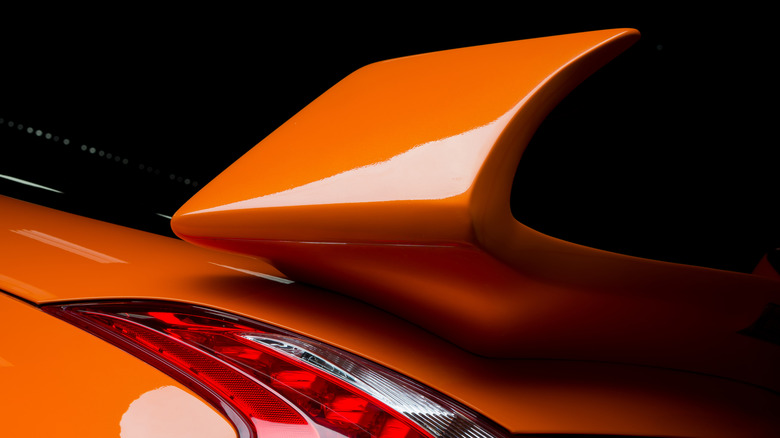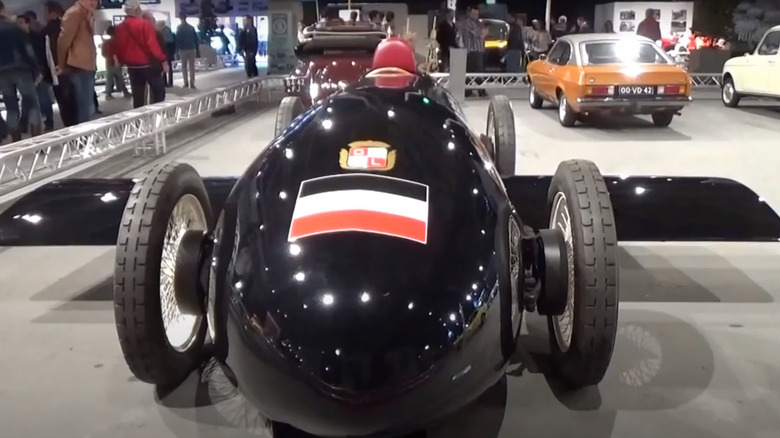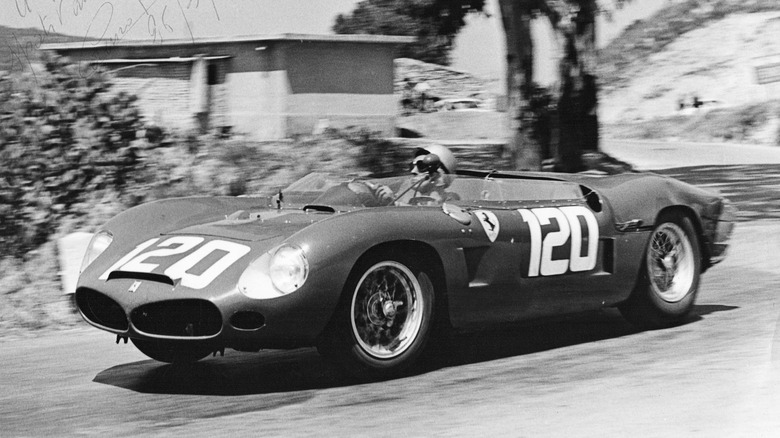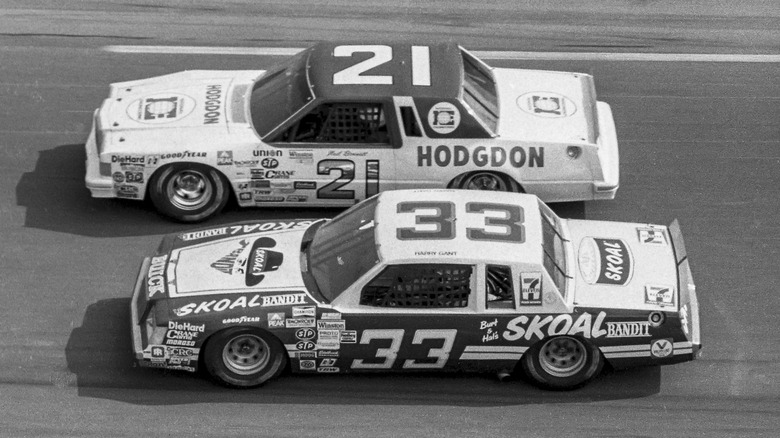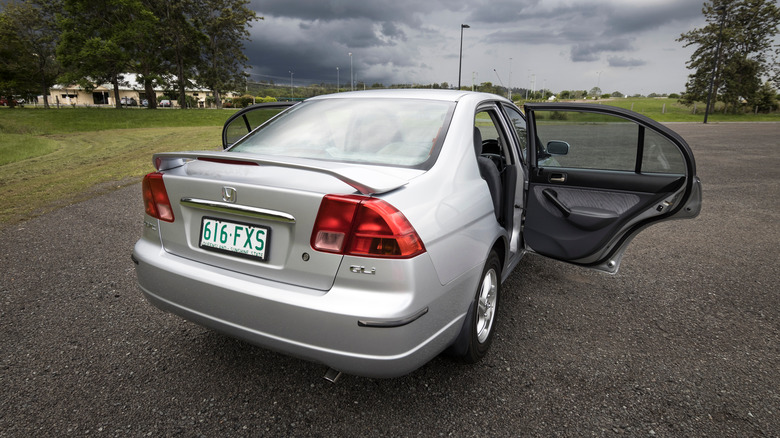The Scientific Reason Car Spoilers Were Invented
Spoiler alert: not all "spoilers" are of the pop-culture kind. For decades, the auto industry has been putting "spoilers" on cars — first on racing vehicles and later on consumer models, as Driving explains. And of course, these types of spoilers have no relation to the movie or TV kind.
The evolution of the car spoiler, on both racing models and consumer models, came about as racing teams fought for a competitive edge (as well as trying valiantly to prevent their cars from crashing horribly). At the same time, our knowledge of physics and how it relates to the automotive industry was growing. And when it comes to cars, aesthetic considerations have come into play, although it bears noting that not all car buyers are impressed by spoilers and want them on their rides. What's more, on most consumer cars, spoilers actually do little real good, at least at the speeds the average driver is going to drive them, according to GoMechanic.
Fluid dynamics
When you think of the phrase "fluid dynamics" — which is to say, the branch of physics that deals with objects' motion through fluids — you may be inclined to conclude that it has nothing to do with cars, whether on the race track or on the street. However, as Live Science explains, in a practical sense, objects move through liquids and gasses in many of the same ways, and so this scientific field is concerned not only with objects' movement through liquids but through the air as well.
Of course, this field of study is important in aviation and space exploration, but it's also quite important when it comes to vehicles on the ground, such as trains, buses, and cars. And the racing industry figured out relatively early on how much of a role fluid dynamics plays in how a car performs on a race track, including (but not limited to) keeping it from crashing spectacularly.
Wings and spoilers aren't the same thing, but they also are
The automotive industry considers wings and spoilers two different things, according to Auto Trader. But for the purposes of this article, they'll be considered one and the same, and for good reason: they serve adjacent purposes based on the same principles.
By the late 1920s, the team behind the Opel-RAK 2 (pictured above) had figured out how to use fluid dynamics to their advantage. We'll spare you the physics of it all, but long story short, the wings protruding from the center of the car create a downward air pressure on them, effectively forcing the car onto the ground. Without the wings, the effects of the air moving around and under the car — particularly at the high speeds attained by the vehicle — could result in the machine flying off into the air, and that wouldn't do. The winged vehicle made its debut in 1928, and it served its purpose admirably as the experimental vehicle attained a top speed of 147 miles per hour, which was unthinkably fast for its time.
The rear spoiler becomes a thing
By the 1960s, the car-racing industry had moved from wings to other means of keeping the vehicles firmly attached to the ground (via Auto Trader). Remember, gravity only does so much. As the vehicle slices through the air, the air moving around and under it will wreak all kinds of havoc, including lifting it up a bit and reducing how much the tires grip the surface, in turn wrecking both handling and fuel economy.
Back in 1961, the team at Ferrari realized that by putting a spoiler on the rear of the 196 Dino SP (pictured above), the team could improve the vehicle's performance, according to Driving. The vehicle began the 1961 racing season without the spoiler but began making use of it as the season progressed. However, Auto Trader puts a different timeline on the introduction of the rear spoiler in the racing industry: the 1968 season, during which the Lotus 49 featured a rear spoiler for the same reasons.
NASCAR helps put spoilers on consumer models
NASCAR was born from the tradition of Southern moonshiners modifying their street-legal vehicles in order to outrun the law, according to History. These days, the illusion is largely shattered — there's very little resemblance between the Chevrolet Jimmie Johnson drives at Daytona and any Chevrolet you can buy and drive — but for decades, NASCAR and street-legal "stock" cars bore some similarities.
By the 1970s, rear spoilers were a thing on NASCAR tracks, with popular driver Richard Petty spinning around the track in a Plymouth Superbird (via Auto Trader). Soon enough, the spoiler began appearing on consumer models. That was followed a few years later by Porsche, which put a rear spoiler on the 911 Turbo. Eventually, according to Jalopnik, spoilers began appearing on not just high-performance sports cars but also on mundane vehicles like the Honda Civic. After all, if it works on the track, then it should work for the consumer, too, right?
Your car doesn't need a spoiler
You may want a spoiler on your car for one of two reasons: either you dig car racing and want other people to know that you're driving a fast, high-powered sports car (or a Honda Civic, pictured above), or you genuinely believe that a spoiler will help with the grip, fuel economy, and other performance-related benefits that spoilers provide on race cars.
Forget about the spoiler providing any real benefits on a street-legal production car, however, says Go Mechanic. In order for the spoiler to provide any real benefit, your car would have to be moving at speeds attainable on the race track and not on city streets or even interstate highways. Long story short, unless you have the means to drive your production car at racing speeds and for extended periods of time, the spoiler on your car is little more than a visual accessory. Whether or not that's a good thing or a bad thing depends, of course, on why you bought a car with a spoiler in the first place.
